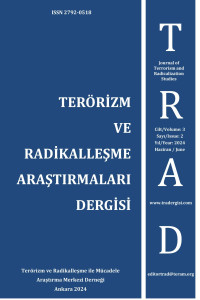Abstract
Suicide terrorism is a phenomenon with conventional warfare and conventional targets/tactics. Suicide attacks, which emerged in the latter half of the 20th century, have been on the rise with each passing day. Uncertainties regarding the reasons why an individual would attempt to collectively kill themselves or others for a belief they hold still persist. The complexity of the phenomenon of suicide terrorism arises from the inability to determine when terrorist organizations carried out suicide attacks in response to which political, religious, or ideological events. The occupation of Afghanistan by the USA after the September 11 attacks and the invasion of Iraq in 2003, along with the instability in the Middle East, contributed to the increase in suicide attacks. This article aims to analyze the ideology, target audience, time/space, purpose/method relationship, the periods in which suicide attacks occurred, and their contributions to terrorist organizations, which are used as acts of killing among the most significant political events in the contemporary world. This research consists of three parts, the first part discusses the debate on the concept of suicide terrorism in the literature. In the second part, hypotheses prepared using the CPOST suicide attack database are analyzed. In the conclusion, suicide attacks carried out in Türkiye are evaluated in proportion to the hypotheses.
References
- Akbar, A. (2013). The thistle and the drone: how America's war on terror became a global war on tribal Islam. Washington, D.C.: Brookıngs Instıtutıon Press.
- Almogy, G., & Mintz, Y. (2006). Suicide bombing attacks can external signs predict internal injuries? Annals of Surgery, 243(4), 541-546.
- Asal, V., & Rethemeyer, R. K. (2008). The nature of the beast: organizational structures and the lethality of terrorist attacks. The Journal of Politics, 70(2).
- Atran, S. (2004). Mishandling suicide terrorism. The Washington Quarterly, 27(3), 67-90.
Abstract
İntihar terörizmi konvansiyonel savaş ve konvansiyonel hedefleri olan karmaşık bir olgudur. 20. yüzyılın ikinci yarısında ortaya çıkan intihar saldırıları her geçen gün artış göstermektedir. Bir insanın, inandığı bir şey için kendisini veya başkalarını kolektif olarak öldürmeye çalışmasının sebebi konusundaki belirsizlikler halen devam etmektedir. İntihar terörizmi olgusunun karmaşıklığı, terör örgütlerinin hangi dönemlerde, hangi siyasi, dini veya ideolojik olaylara karşı intihar saldırısı gerçekleştirdiği belirlenemediğinden kaynaklanmaktadır. 11 Eylül saldırıları sonrasında ABD’nin Afganistan’ı, 2003 yılında Irak’ı işgali ile Ortadoğu’da yaşanan istikrarsızlık intihar saldırılarının artmasına neden olmuştur. Bu makale, günümüz dünyasının en önemli siyasal olayları arasında yer alan bir öldürme eylemi olarak kullanılan intihar saldırılarının ideolojisini, hedef kitlesini, zaman/mekân ve amaç/yöntem ilişkisini, hangi dönemlerde intihar saldırısı gerçekleştirildiğini ve son olarak terör örgütlerine olan katkılarını değerlendirmektir. Bu araştırma sonuç kısmıyla birlikte üç bölümden oluşmaktadır. İlk bölümde intihar terörizmi kavramının literatürdeki tartışmasına yer verilmiştir. İkinci bölümde Chicago Project on Security and Terrorism CPOST intihar saldırıları veri tabanı kullanılarak hazırlanan hipotezler analiz edilmiştir. Araştırmanın sonuç kısmında ise Türkiye’de gerçekleştirilen intihar saldırıları hipotezlerle doğru orantılı olarak değerlendirilmiştir.
Keywords
İntihar Terörizmi İntihar Saldırıları İntihar Saldırılarının Stratejisi Terörizm Motivasyon
References
- Akbar, A. (2013). The thistle and the drone: how America's war on terror became a global war on tribal Islam. Washington, D.C.: Brookıngs Instıtutıon Press.
- Almogy, G., & Mintz, Y. (2006). Suicide bombing attacks can external signs predict internal injuries? Annals of Surgery, 243(4), 541-546.
- Asal, V., & Rethemeyer, R. K. (2008). The nature of the beast: organizational structures and the lethality of terrorist attacks. The Journal of Politics, 70(2).
- Atran, S. (2004). Mishandling suicide terrorism. The Washington Quarterly, 27(3), 67-90.
Details
| Primary Language | English |
|---|---|
| Subjects | International Security |
| Journal Section | Research Articles |
| Authors | |
| Publication Date | June 28, 2024 |
| Submission Date | March 11, 2024 |
| Acceptance Date | April 28, 2024 |
| Published in Issue | Year 2024 Volume: 3 Issue: 2 |


